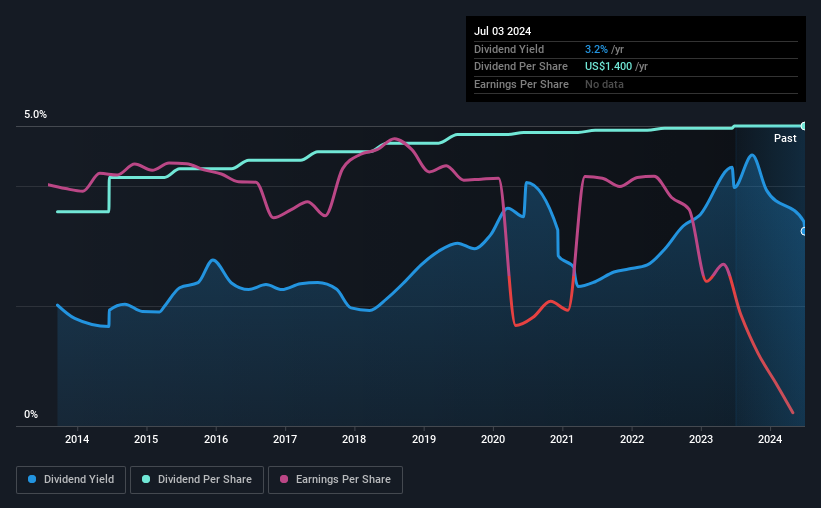- United States
- /
- Media
- /
- NYSE:WLY
Don't Race Out To Buy John Wiley & Sons, Inc. (NYSE:WLY) Just Because It's Going Ex-Dividend

John Wiley & Sons, Inc. (NYSE:WLY) is about to trade ex-dividend in the next four days. Typically, the ex-dividend date is one business day before the record date which is the date on which a company determines the shareholders eligible to receive a dividend. The ex-dividend date is an important date to be aware of as any purchase of the stock made on or after this date might mean a late settlement that doesn't show on the record date. Accordingly, John Wiley & Sons investors that purchase the stock on or after the 9th of July will not receive the dividend, which will be paid on the 25th of July.
The company's next dividend payment will be US$0.3525 per share, on the back of last year when the company paid a total of US$1.40 to shareholders. Looking at the last 12 months of distributions, John Wiley & Sons has a trailing yield of approximately 3.2% on its current stock price of US$43.12. Dividends are an important source of income to many shareholders, but the health of the business is crucial to maintaining those dividends. As a result, readers should always check whether John Wiley & Sons has been able to grow its dividends, or if the dividend might be cut.
See our latest analysis for John Wiley & Sons
Dividends are typically paid from company earnings. If a company pays more in dividends than it earned in profit, then the dividend could be unsustainable. John Wiley & Sons reported a loss after tax last year, which means it's paying a dividend despite being unprofitable. While this might be a one-off event, this is unlikely to be sustainable in the long term. With the recent loss, it's important to check if the business generated enough cash to pay its dividend. If John Wiley & Sons didn't generate enough cash to pay the dividend, then it must have either paid from cash in the bank or by borrowing money, neither of which is sustainable in the long term. Over the last year it paid out 73% of its free cash flow as dividends, within the usual range for most companies.
Click here to see how much of its profit John Wiley & Sons paid out over the last 12 months.

Have Earnings And Dividends Been Growing?
Companies with falling earnings are riskier for dividend shareholders. If earnings fall far enough, the company could be forced to cut its dividend. John Wiley & Sons reported a loss last year, and the general trend suggests its earnings have also been declining in recent years, making us wonder if the dividend is at risk.
Many investors will assess a company's dividend performance by evaluating how much the dividend payments have changed over time. Since the start of our data, 10 years ago, John Wiley & Sons has lifted its dividend by approximately 3.4% a year on average.
We update our analysis on John Wiley & Sons every 24 hours, so you can always get the latest insights on its financial health, here.
To Sum It Up
Is John Wiley & Sons worth buying for its dividend? It's hard to get used to John Wiley & Sons paying a dividend despite reporting a loss over the past year. At least the dividend was covered by free cash flow, however. Overall it doesn't look like the most suitable dividend stock for a long-term buy and hold investor.
With that in mind though, if the poor dividend characteristics of John Wiley & Sons don't faze you, it's worth being mindful of the risks involved with this business. For example, we've found 3 warning signs for John Wiley & Sons that we recommend you consider before investing in the business.
A common investing mistake is buying the first interesting stock you see. Here you can find a full list of high-yield dividend stocks.
New: Manage All Your Stock Portfolios in One Place
We've created the ultimate portfolio companion for stock investors, and it's free.
• Connect an unlimited number of Portfolios and see your total in one currency
• Be alerted to new Warning Signs or Risks via email or mobile
• Track the Fair Value of your stocks
Have feedback on this article? Concerned about the content? Get in touch with us directly. Alternatively, email editorial-team (at) simplywallst.com.
This article by Simply Wall St is general in nature. We provide commentary based on historical data and analyst forecasts only using an unbiased methodology and our articles are not intended to be financial advice. It does not constitute a recommendation to buy or sell any stock, and does not take account of your objectives, or your financial situation. We aim to bring you long-term focused analysis driven by fundamental data. Note that our analysis may not factor in the latest price-sensitive company announcements or qualitative material. Simply Wall St has no position in any stocks mentioned.
Have feedback on this article? Concerned about the content? Get in touch with us directly. Alternatively, email editorial-team@simplywallst.com
About NYSE:WLY
Average dividend payer and slightly overvalued.


